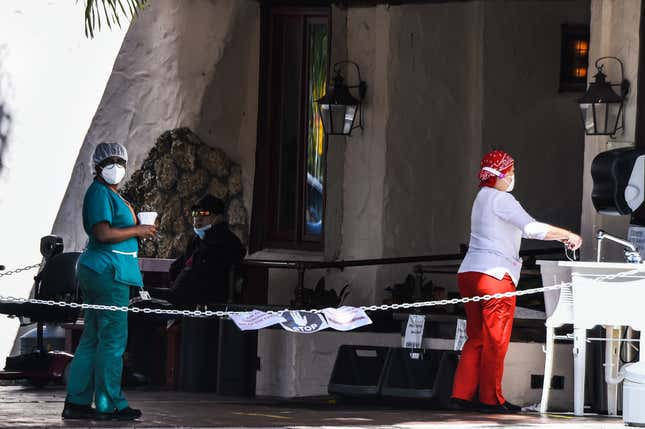
A reporting investigation by the New York Times and the Baltimore Sun has uncovered deep racial disparities in nursing homes hit by the coronavirus. From the beginning of the pandemic, the elderly were identified as particularly vulnerable to suffering the worst effects of the novel virus. But the data parsed by the Times and the Sun show to what extent this public health crisis hinges on racial divides.
The investigation found that no matter where a nursing home was located, its government rating, or its size, if it housed a substantial amount of black and Latinx residents, it was twice as likely to get hit by the coronavirus as homes where the population was “overwhelmingly white,” the Times writes.
For nursing homes where at least a quarter of the residents are black or Latinx, more than 60 percent have at least one coronavirus case. “That is double the rate of homes where black and Latino people make up less than 5 percent of the population,” the paper notes, adding that in these environments, single cases can quickly escalate into an outbreak.
In fact, race and ethnicity were a predictor of whether a home was hit by COVID-19 in a way that quality was not. The federal government has a five-star rating system for nursing homes to denote the quality of care one can expect in it. According to the data, predominantly black or Latinx homes with high ratings were more likely to have coronavirus cases than white nursing homes with low ratings.
Other important factors didn’t level out the racial disparities—not the size of the nursing home, nor the infection rates in the surrounding community, nor the number of residents who received Medicaid or Medicare (an indication of wealth and access to healthcare). Even factoring in population density of the surrounding neighborhood—considered so far to be a major risk factor for contracting the virus—didn’t equalize the racial data.
The analysis looked at 22 states most deeply impacted by the coronavirus and which had data available as of May 16. The District of Columbia was also included. The Times cautioned that the data represented just “a snapshot in time,” noting that as the crisis evolves, the data could also shift.
Nursing homes in Eastern states have been hardest hit so far: Maryland had one of the highest infection rates reported in its nursing homes, as did New Jersey, Massachusetts and Connecticut. It’s important to note here, however, that some states have not reported complete data about their nursing homes, which makes comparisons difficult.
While the exact causes of the discrepancies aren’t yet clear—and can’t be until comprehensive data is collected and shared—the data further illuminates how segregated American life is: from childhoods spent in segregated schools to end-of-life care given in segregated nursing homes.
Terry Fulmer, president of The John A. Hartford Foundation, which advocates for improved care for the elderly, pointed to this big-picture trend when trying to surmise the troubling disparities. She told the Sun the data was another indicator of the vastly different America black people and Latinx live in.
“They start off at a disadvantage, and it snowballs throughout their lives,” she said. “It doesn’t stop at the nursing home.”

